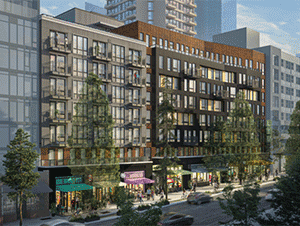Fire walls are the most robust form of fire-rated assemblies in the Building Code and have strict rules for their construction and continuity. In Seattle, fire walls are being used more frequently for a variety of reasons, including:
- Fire walls are required for compartmentalization when building 6 stories of wood construction using the Seattle amendment to promote more affordable housing (SBC 510.10)
- Fire walls are used to subdivide a building into separate “buildings,” either to change the occupancy designation or to separate new construction from existing
Many designers include modulation of the exterior façade, both for visual interest and as required by the Land Use Code. Since the Building Code is not clear how to handle the intersection of a fire wall with an exterior wall that is not a simple configuration, we have recently published a new Fire Wall Continuity at Offsets Code Interpretation to clarify our policy for fire wall continuity at exterior walls.
This code interpretation is intended to be used in conjunction with our previous Fire Wall Continuity Code Interpretation, and specifically focuses on fire wall terminations that are located on a modulating façade. We hope it will lead to more consistent review of these important fire safety features and provide guidance for architects so they can incorporate the required details early in the design process.
If you have questions, please contact:
Amy Barnett
(206) 684-3965
amy.barnett@seattle.gov
Alan Lee
(206) 256-5318
AlanW.Lee@seattle.gov
